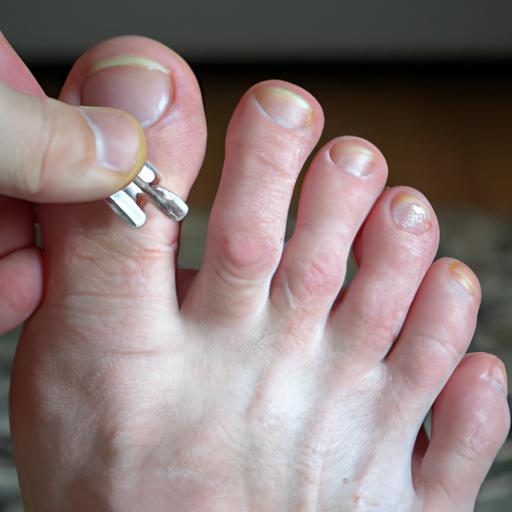Table of Contents
Introduction
White toenails can be a cause for concern, especially for those who value their appearance. The discoloration can be a sign of an underlying condition that requires medical attention. In this article, we will explore the causes of white toenails, their symptoms, diagnosis, treatment, and prevention to help you understand the condition better.
Causes of White Toenails
White toenails can be caused by various factors, including fungal infections, psoriasis, trauma, nutritional deficiencies, and allergic reactions.
Fungal Infections
Fungal infections are the most common cause of white toenails. These infections occur when fungi invade the nail bed, making it thickened, brittle, and discolored. The infection can be caused by different types of fungi, such as dermatophytes, yeasts, and molds. Fungal infections are prevalent in people who wear closed shoes for extended periods, have sweaty feet, or use public showers and swimming pools.
Psoriasis
Psoriasis is a chronic autoimmune condition that affects the skin, nails, and joints. It can cause the toenails to become thickened, yellow, or white. Psoriasis occurs when the immune system attacks healthy skin cells, resulting in inflammation, flaking, and scaling.
Symptoms of White Toenails
White toenails can manifest in various ways, depending on the underlying cause. The most common symptoms include:
Discoloration
The toenails become white or yellowish, indicating an infection or an underlying health condition. The discoloration can spread to the entire nail, making it thickened, brittle, and deformed.
Pain
White toenails can be painful, especially when the infection is severe. The pain can be a sign of inflammation, nerve damage, or tissue damage.
Brittle Nails
White toenails can become brittle, fragmented, and prone to breakage. The nails may lose their natural shine and become dull.
Thickened Nails
White toenails can become thickened, leading to discomfort and difficulty wearing shoes. The thickening can be a sign of an infection or a chronic condition such as psoriasis.
Foul Odor
White toenails can produce an unpleasant and embarrassing foul odor, indicating a bacterial or fungal infection. This can affect a person’s self-esteem.
Diagnosis of White Toenails
To diagnose white toenails, a doctor will perform a physical examination, laboratory tests, and imaging studies. The examination may involve checking for signs of infection, inflammation, or trauma. The doctor may also ask about the person’s medical history, lifestyle habits, and symptoms.
Laboratory tests may include a nail culture, where a sample of the nail is taken and grown in a lab to identify the type of fungi or bacteria causing the infection. Blood tests may also be conducted to check for underlying health conditions such as diabetes or thyroid disorders.
Imaging studies such as X-rays or ultrasound can help examine the bones, joints, and soft tissues surrounding the toenail, helping to identify any abnormalities that may be causing the discoloration or pain.
Treatment of White Toenails
The treatment of white toenails depends on the underlying cause. The most common treatment options include antifungal medications, topical creams or ointments, oral medications, surgery, and lifestyle changes.
Antifungal Medications
Antifungal medications are the most effective treatment for fungal infections that cause white toenails. They can be taken orally or applied topically to the affected area. The medication works by eliminating the fungi responsible for the infection. It is essential to complete the entire course of medication, even if the symptoms disappear before the end of the treatment.
Topical Creams or Ointments
Mild fungal infections can be treated with topical creams or ointments. These are applied directly to the affected area and may take several months to clear the infection.
Oral Medications
Severe fungal infections that do not respond to topical treatments may require the use of oral medications. These medications are taken daily for several months but can have side effects such as liver damage.
Surgery
Surgery is a last resort option for white toenails caused by trauma or other underlying conditions. It involves removing the affected toenail under local anesthesia.
Lifestyle Changes
Adopting certain lifestyle changes can help prevent white toenails. These include maintaining good foot hygiene, proper nail care, wearing breathable shoes and socks, avoiding trauma, and consuming a balanced diet.
Prevention of White Toenails
Preventing white toenails involves taking measures to reduce the risk of developing fungal infections, trauma, and other underlying conditions. Some preventive measures include:
Good Foot Hygiene
Maintain good foot hygiene by washing your feet daily with soap and water, thoroughly drying them, and applying moisturizer to prevent dryness.
Proper Nail Care
Practice proper nail care by cutting your nails straight across, avoiding cutting them too short, using clean nail clippers, and refraining from biting nails or picking at the cuticles.
By understanding the causes, symptoms, diagnosis, treatment, and prevention of white toenails, you can take proactive steps to ensure the health and appearance of your nails. Remember to consult with a healthcare professional for an accurate diagnosis and treatment plan tailored to your specific needs.






